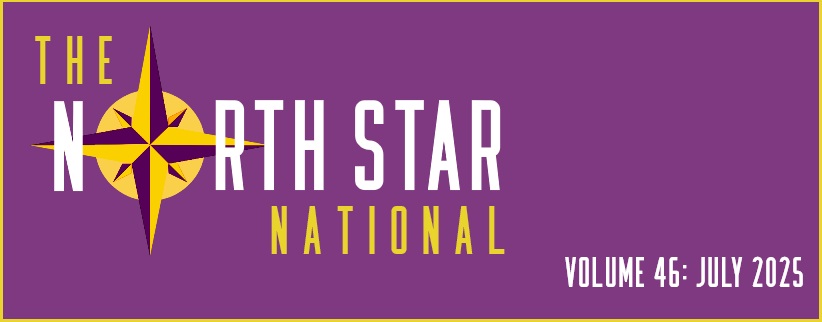
New Logo, New Colors . . . Just Because We Like Them!
 For the first time since 2014 – and only the second time in our history – our company has embraced a new logo and new colors.
For the first time since 2014 – and only the second time in our history – our company has embraced a new logo and new colors.
The new colors are purple, gold and white. The concept is a bit of a nod to the way-back original North Star logo, only in terms of how it uses the star to stand in for the O in North. If any of you remember this one, you’ve known us way too long:

We talk in some detail in the video above about why we like it. The bolder colors and the bright attitude definitely are a better representation of our company’s personality today – and maybe of the way we like to write engaging copy for our clients instead of formulaic corporate drivel.
But the bottom line is: We just like it! We’ve got some cool ideas in the works about what we’ll do with business cards and so forth.
The logo works with purple type for NORTH STAR against a white background, or as you can see in the video above, it also works with white type for NORTH STAR against a purple background. The lettering for MARKETING CONENT is always gold.
And the star can stand alone as an icon.
We don’t think companies should change their logos and colors too often, and it’s no substitute for good work. But if you really don’t think your logo represents you, or you don’t feel enthusiastic about showing it off to people – then change it to something you love!
That what we just did, which is why we took the unusual step of featuring the logo on this month’s Six Questions with Dan and Michelle.
Should We Write At An Eighth-Grade Level Because That Is Supposedly the Prevailing Reading Level?

You might know there’s a school of thought in writing: You have to write at an eighth-grade level because that’s the reading level of the majority of Americans. Combine that with the notion that “people don’t have time to read” and you end up with very short, very elementary copy that doesn’t tell you much of anything.
This is how we’re supposed to express the business value of a cybersecurity consultant? Or a technology developer? Or a logistics services firm? Or a nonprofit consulting company? Or a 3PL?
We think differently about this. Regardless of where the mainstream of society may or may not be, we believe the key audiences of our clients should be addressed like the adults and the professionals they are. We will use complex sentences if an idea calls for it. We will use big words – not gratuitously (there’s one right there!) but if it’s the best word to express an idea, you bet. We will avoid acronyms most of the time because we think it’s better to be clear than to be quick.
Remember, our job is to tell the story of the value each client provides. And our first priority is to tell it to the client’s “village,” which consists of audiences like current and former clients, current and former employees, vendors, professional associates, relevant industry media and others who are already close to them and are in a position to serve as ambassadors and referral sources. They already know the basics. Our job is to build on their knowledge and understanding of the company with greater detail and insight.
With all due respect to eighth-graders (we were that once too), we think people in the professional world who deal with our clients can handle a bit more sophistication.
Now, there are limits to this. Early in Dan’s career when he was with Franco Public Relations Group, he had a client who would tell him not to make the copy he wrote too easy for readers to understand. If they didn’t come away from it confused, the client explained, he might not come off as intellectually superior like he thought he needed to.
That’s ridiculous. Being hard to understand doesn’t make you smart. Being able to express yourself clearly and effectively makes you smart.
But we do think the business community sometimes dumbs down its message for the lowest-common-denominator audience, or for the most impatient.
We think our clients’ stories are worth a few extra minutes to read in full. We think the depth of what they do deserves some more sophisticated words on occasion, or even a long sentence!
And we think you can handle reading that. So we’ll continue to write that way.
Last Week in Bible Study: Churches Receive Sternly Worded Letters

In keeping with the piece above, we don’t really go for the fluff when it comes to Bible Study either – so we’ve started for the third time through a study of Revelation.
We just worked through the early chapters in which Jesus has John send letters to the angels of seven major churches in the region.
And we note that Jesus made it clear: He is not going to put up with their accommodation of sin or bad teachings. He gives them a chance to get their act together, but He warns that eventually He will take their standing away if they persist.
We all understand this in business. If you’re not doing what’s expected of you, you lose jobs, clients and eventually your professional reputation.
We like to think of Jesus as endlessly patient and compassionate, but He isn’t here to just put up with nonsense – especially the kind he died and rose again to get rid of.
